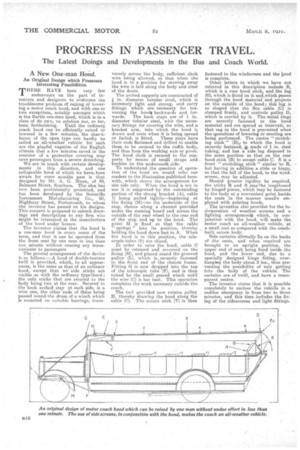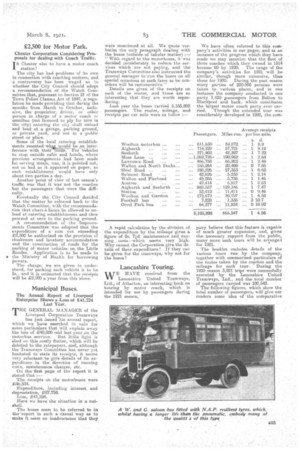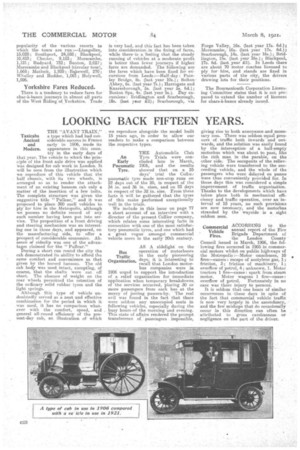PROGRESS IN PASSENGER TRAVEL.
Page 20

Page 21

Page 22

If you've noticed an error in this article please click here to report it so we can fix it.
The Latest Doings and Developments in the Bus and Coach World.
A New One-man Hood.
An Original Design which Possesses Interesting Possibilities. THERE HAVE been very few endeavotu-s on the part of inventors and designers to ove-icome the troublesome problezn of raising gal% lowering a motor coach hood, and with one or two exceptions, notably amongst which is the Bartle one-man hood, Which is in a class of its own, no solution has, so far, been forthcoming. Until the ordinary coach hood can be efficiently raised or lowered in a few minutes, the char-abanes of the open type can hardly be called an all-weather vehicle for such are the playful vagaries of the English climate that a few minutes saved in the erection of a protective covering may save passengers from a severe drenching. We are in touch with certain developments in this direction, and one collapsable hood of which we have_ been aware for some months past is -that designed by Mr. A, C. Nunn, of 49, Belmont Street, Southsea. The idea has now been provisionally protebted, and has been developed by the Scientific Instrument Manufacturing Co., 60, Highbury. Street, Portsmouth, to whom the inventor has passed on his designs. This concerti is prepared to submit drawings and descriptions to any firm who might be interested. in the manufacture of the hood under licence.
The inventor claims that the hood is a one-man hood in every sense of the term, and that it can be operated front the front seat by one man in less than one minute without causing any inconvenience to passengers The general arrangement of the device is as follows :—A hood of double-texture twill is provided, which, to all appearances, is the same as that of an ordinary hood, except that no side Sticks are visible as with the ordinary typeihood ; the only sticks that are secured to the body being twO at the rear. Secured to the back arched stay at each side, is a wire one, the other ends of these being passed round the drum of a winch which is mounted on suitable bearings, trans
versely across the body, sufficient slack wire being allowed, so that when the hood is in a position for stowing away the wire is laid along the body and clear of the doors.
The arched supports are constructed of
in. diameter tubular steel, which is extremely light and strong, and carry fittings which are necessary for traversing the hoods -backwards and for
wards. The back stays are of in. diameter tubular steel, with the necessary fittings for securing the wire, and a bracket arm, into which the hood is drawn and rests when it is being spread or furled, is fitted. These stays have their ends flattened and drilled to enable them to be secured to the coirch body, and thus form the working axis or pivot. The hood cloth is secured to the supports by 'means of smell straps and , buckles on the underneath side. •
To understand the question of operation of the hood we would refer our readers to the illustration published herewith, which shows the arrangement for one side only. When the hood is not in use it is supported( by the outstanding portion of the strong bracket (A), cable C being pulled tightly—beginning at the fixing (M)=to the underside of the step, thence along a channel provided under the running board and across the outside of the rear wheel to the rear end of the step. and up to the hood. The point M Is fixed . so that the cable " springs " into its position, thereby bolding the hood down fast to A. When the hood is in this position, the telescopic tubes (i) are closed.
In order to raise the hood, cable C must be released and reversed on the fixing (M), and placed round the grooved pulley (L), which is_secureiy fastened to the front end of the chassis frame. Fitting G is now dropped into the top of the telescopic tube (F), and is then raised by the small geared winch Until the wire (C) is bar taut. This operation completes the work necessary outside the coach.
The tool provided now rotates pulley thereby drawing the hood along the cable (C). The screen stick (T) is then fastened to the windscreen and the hood is complete.
Other letters to which we have not referred in this description include B, which is a rear hood stick, and the lug B2, which is fitted on it and,_which pusses through the hood material and projects on the outside of the hood; this lug is so shaped that the flex cable (C) is clamped firmly, and controls pulley 1.), which is carried by it. The metal rings are securely fastened to the hood material and are spaced at intervals, so that sag in the hood is prevented when' the operations of lowering or erecting are being performed. The centre "stretching stack " (R),. to which the hood is securely fastened, ida made of 1 in, steel tubing, and has a side lug disposed in the same position as that on the rear hood stick (B) to accept cable C. S is a front " stretching stick " similar 'to R, but having in addition a slide or hinge, so that the fall of the hood, to the windscreen, may be adjusted.
Should greater rigidity be required, the sticks R and S maybe lengthened by hinged pieces, which may be fastened to the body at a convenient point,beside the seats in the manner usually employed with existing hoods. The invention also provides for the incorporation of weather screens and a lighting arrangement which, in conjunction with the hood, Will make the motor coach an all-weather vehicle, at a small cost as .compared with the coachbuilt saloon body.
Side curtains ifilIrrearly Tie on the backs of the seats, and when required are brought to an upright position, the upper end of each being fixed inside the hood, and the lower end, due to a specially designed hinge fitting, overhangingthe body about 3 ins., thus preventing the possibility of rain getting" into the body of the vehicle. The curtains are of twill, and have a transparent centre.
The inventor states that it is possible completely to enclose the vehicle in a sudden emergency in from two to three minutes, and this time includes the fixing of the sidescreens and light fittings.
£2,500 for Motor Park.
Chester Corporation Considering proposals for dealing with Coach Traffic.
I S Chester also to have a motor coach • station?
The city has had problems of its own in connection With coaching matters, and • coritroversy has been waged as to
whether the City Council should adopt a recommendation of the Watch Committee that, pursuant to Section 21 of the Town Police Clauses Act of 1847, a regulation be made providing that during the months from March to October, inclusive, the proprietor' driver, or other person in charge of a motor coach or
• omnibus (not licensed to ply for hire in the city) entering the city shall unload and load at a garage, parking ground, or private yard, and not in a public street or place.
Some of the local catering establishments resented whg_would be an interference with their-Tih-drTar 'vehicles to *top outside cafés and hotels, where previous arrangements had been made for serving meals, was, it is pointed out, not so bad as it appeared on paper, as each establishment would have only about two parties a day.
Another point of view of last season's traffic was that it was not the coaches but the passengers that were the difficulty.
Eventually the City Council deeided that the matter be referred back to the Watch Committee, with the recommendation that chars-a-banes be allowed to unload at catering establishments and then proceed at once to the parking ffround.
A recommendation of the Improvements Committee was adopted that the expenditure of a sum not exceeding £2,500 be authorized on the provision of cloakroom and lavatory accommodation and the construction of roads for the parking of motor vehicleson. theLittle Roodee. Application is to be made to • the Ministry of Health for borrowing powers.
The charge, we are given to understand, hae parking each vehicle is to be 5s. and it is estimated that the receipt* will be £2,099 a year from this alone.
Municipal Buses.
The Annual Report of Liverpool Enterprise Shows a,Loss of £41,224 Last War.
THE GENERAL MANAGER of the Liverpool Corporation Tramways has just issued his annual report, which we have searched in vain for some particulars that will explain away the loss of £40,000 odd last year on the
motorbus services. But little light is shed on this costly flutter, which will be debited to the ratepayers, and, although the Tramways Committee has never yet hesitated to state its receipts, it seems very reluctant to giVe details of its expenditure in the direction of running costs, maintenance charges, etc.
On the' first page of the report it is stated that : The receipts on the MOiOrb9.1.5eS were £46,534.
.Expenditure, including interest, and depreetation, £87,759.
Less, £41,224.
Here we have the situation in a nutshell.
The buses seem to be referred n
the '-report in such a casual way as to make it seem an inadvertence that they were mentioned at all. We .quote verbaties the only paragraph dealing with the buses (outside of tabular matter) :"With regard to the rhotorbu.ses, it was decided considerably to reduce the services which are not paying, and. the Tramways Committee also instructed the general manager to run the buses on all special occasions at such fares as he considers will be remunerative."
Details are given of the receipts on each of the routes, and these are so interesting that they are worth reproducing.
Last year the buses carried 5,185,898 passengers. The routes, mileage, and receipts per ear mile were as follow : A rapid calculation by the division of the expenditure by the mileage gives a .figure of 2s. 70. maintenance and runfling, costs-which seems very high. Why cannot the Corporation give the details of their expenditure? It they can be given for the tramways, why not for the buses?
Lancashire Touring.
wE HAVE received from the Lancashire United Tramways, Ltd., of Atherton, an interesting book on touring by motor coach, which is intended for use by passengers during the 1921 season.
We have often referred to this company's activities in our pages, and as an instance of the progress which they have made we may mention that the fleet of three coaches which they owned in 1914 became 60 by 1920. The range of the company's activities for 1921 will be similar, though more extensive, than those for 1920. During the past season many parties of 200-500 persons were taken to various places, and in one instance the company conducted in one party 1,450 passengers from Bolton to Blackpool and back, which constitutes the largest motor coach party, ever carried. Though the extended tour was considerably developed in 1929, the coin pony believe that this feature is capable of much greater expansion, and, given the necessary support from the public, many more such tours will be arranged for 1921.
The booklet includes details of the various tours run by the company, together with summarized particulars of the routes taken by the co.aches and the mileage for each tour. During the 1920 season 3,921 trips were successfully executed by the Lancashire United Tramways, eAd., and the total number of passengers carried was 100,542.
The following figures, which show the total number of passengers, will give otlir readers some idea of the comparative popularity of the various resorts to which the tours are run:—Llangollen, 15,028; Southport, 24,588; Blackpool, 10,423; Cheeter, 9,183; Pslorecambe, 1,121; Rudyard, 732; Buxton, 2,027; Morecambe,athi Blackpool (circular tour), 1,668; Matlock, 1,929; • Bkkewell, 270; Whalley and Hodder, 1,081; Holywell, 1,596.
Yorkshire Fares Reduced.
There is a tendency to reduce fares for char-k-bancs journeys in almost all parts of the West Riding of Yorkshire. Trade
is very bad, and this fact has been taken into consideration rn the fixing-of fares, while there-is a feeling that the steady running of vehicles at a moderate profit is better than fewer journeys if higher fares are demanded. Thefollowing are the fares which have been fixed for exclusions from Leeds :—Half-day: Pateley Bridge, Els. (last year 10s.); Bolton Abbey, 6s. (last year 7s.); Harrogate and .knaresborough, Sc. (last year 5s. 6d.); Boston Spa, 4s. (last year 5s.). Day excursions; Bridlington and Scarborough, las. (last year £1); Scarborough, via Forge -Valley, 16s. (last year 17s. 6d.); Morecambe, 16s. (last year 17s. 6d.); Scarborough, 14s. (last year 16s.); Bridlington, 15s. (last year 16s.); Blackpool,
17s. 6d. (last year In Leeds there are about 70 motor coaches licensed to ply for hire, and stands are fixed in various parts of the city, the drivers drawing lots for their positions.
The Bourneniouth Corporation Licensing Committee states that it is not pre= pared to extend the number of licences for chars-a-bancs already issued.
































